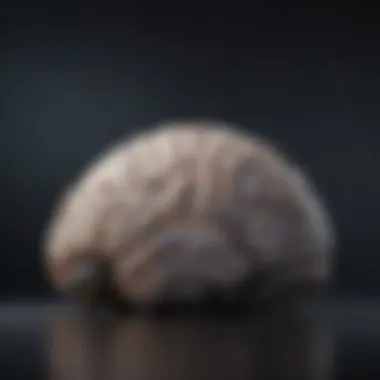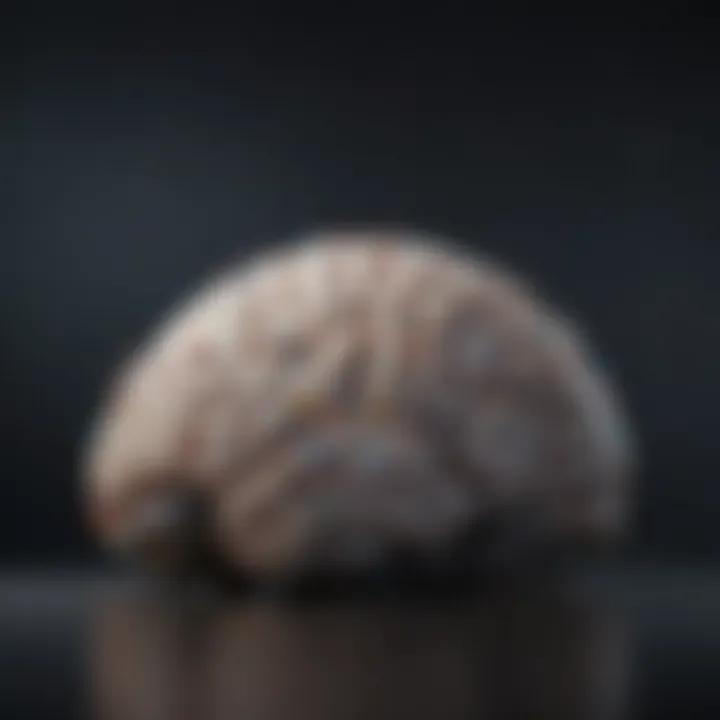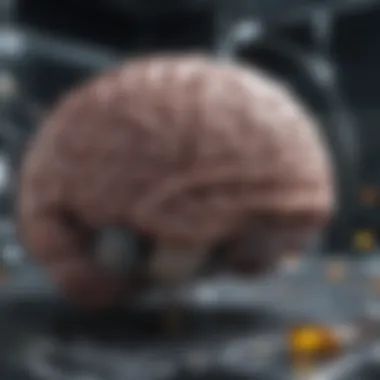Functional Brain Mapping: Understanding Neural Architecture


Intro
Functional brain mapping is an essential endeavor in contemporary neuroscience, intricately linking cognitive functions to specific neural activities. This exploration not only enhances our understanding of the brain's architecture but also sheds light on how our thoughts and behaviors manifest. As the tools for measuring and visualizing brain activity evolve, the implications of these findings reach across diverse fields such as clinical psychology, cognitive science, and education.
In this article, we will look at methodologies ingrained in functional brain mapping, its relevance to current scientific discussion, and the ethical considerations it engenders. By reviewing existing literature, we aim to provide a robust framework that elucidates the relationship between brain function and cognitive processes, ultimately contributing to the overarching discourse in neuroscience.
Research Overview
Summary of Key Findings
Functional brain mapping has unveiled substantial insights into how distinct regions of the brain contribute to various cognitive functions. Neuroimaging techniques such as fMRI and PET scans have enabled researchers to observe real-time brain activity, leading to discoveries that were previously hypothetical. For instance:
- Specific areas of the prefrontal cortex are linked to decision-making.
- The hippocampus is crucial for memory formation and retrieval.
- The amygdala plays a pivotal role in emotional responses.
These findings illustrate a nuanced understanding of brain organization and its direct correlation with behavior and cognition.
Relevance to Current Scientific Discussions
The research surrounding functional brain mapping remains at the forefront of scientific inquiry. As cognitive neuroscience pieces together the intricate puzzle of human thought and action, debates about the implications of these findings become paramount. Discussions often center on the clinical applications, such as:
- Diagnosis of neurological disorders: Brain mapping aids in identifying abnormalities in structures associated with conditions like Alzheimer’s and schizophrenia.
- Rehabilitation strategies: Insights from brain activity patterns inform therapeutic interventions for stroke recovery or cognitive impairments.
Understanding these connections encourages interdisciplinary collaboration, where fields such as psychology and neurology converge to push the boundaries of what we know about the mind and brain.
Methodology
Research Design and Approach
The design of studies in functional brain mapping typically involves a combination of experimental and observational techniques. Researchers may structure experiments that engage subjects in specific tasks while monitoring their brain activity. This structured approach helps isolate the neural correlates of cognitive processes.
Data Collection and Analysis Techniques
Data collection employs a variety of neuroimaging techniques:
- Functional Magnetic Resonance Imaging (fMRI): Measures brain activity by detecting changes in blood flow, providing a dynamic picture of neural engagement.
- Positron Emission Tomography (PET): Uses radioactive tracers to visualize metabolic processes in the brain, offering insights into functionality.
After acquisition, the data undergoes rigorous analysis through various statistical methods to identify patterns and correlations. This analysis is critical in confirming hypotheses and enhancing the scientific base of cognitive neuroscience.
"Functional brain mapping stands as a testament to our growing understanding of the brain's capabilities, providing profound insights into cognition, behavior, and mental health."
Through careful exploration of methodologies and findings, this article serves to illuminate the vital field of functional brain mapping and its significance for future research and applications.
Prelude to Functional Brain Mapping
Functional brain mapping is a pivotal aspect of understanding the intricacies of the human brain. It encompasses various methodologies and technologies that allow scientists and clinicians to visualize and interpret brain activity. This section lays the groundwork for the entire article by elucidating the significance of brain mapping in both research and clinical environments.
The importance of functional brain mapping cannot be overstated. It provides insights into how different brain regions interact and contribute to cognition and behavior. Understanding these connections can lead to better treatments for neurological disorders, enhance educational methods, and inform strategies for mental health interventions. Moreover, the exploration of functional brain mapping fosters interdisciplinary collaboration among cognitive scientists, neurologists, and engineers.
Definition and Overview
Functional brain mapping refers to the set of techniques used to systematically analyze brain activity associated with specific cognitive functions. It extends beyond traditional anatomical studies by integrating the dynamic components of brain function. The core goal is to create a detailed representation of how different areas of the brain work together when performing various tasks. Technologies, such as fMRI and EEG, are critical for achieving these visualizations. These methods allow researchers to track changes in brain activity as subjects engage in cognitive tasks, offering insights into the neural basis of thoughts, feelings, and actions.


Historical Context
The journey of functional brain mapping has evolved significantly over the decades. Initially, our understanding of the brain was predominantly anatomical, relying mostly on post-mortem examinations. However, with the advent of neuroimaging in the late 20th century, researchers began to visualize live brain activity. The introduction of technologies like functional magnetic resonance imaging (fMRI) in the 1990s revolutionized the field, enabling scientists to observe real-time changes in blood flow related to neural activity.
Researchers like Roger Sperry and Michael Gazzaniga laid the groundwork with their studies on split-brain patients, revealing the functional lateralization of the brain. These early findings set the stage for what would become a comprehensive exploration of brain functionality. As methodologies advanced, so did our ability to understand complex cognitive processes, leading to the modern landscape of cognitive neuroscience.
Neuroimaging Techniques
Neuroimaging techniques represent a critical facet of functional brain mapping. They provide the tools needed to visualize and study the brain's complex activities and functions in real time. These methods bridge the gap between cognitive neuroscience and clinical practice, yielding insights that drive both research and therapeutic strategies. The ability to observe neural activity allows researchers and clinicians to investigate how specific brain regions contribute to various cognitive functions and behaviors.
The primary benefit of neuroimaging techniques is their non-invasive nature. This property enables the study of brain function without requiring surgical procedures, making it safer for participants. Moreover, different techniques offer unique advantages and data types, further enriching the understanding of neural correlates of human behavior and cognition.
However, each technique has considerations that affect its application and interpretation. Factors such as temporal resolution, spatial resolution, and sensitivity to specific neural activities must be carefully weighed. Understanding these factors is essential for accurate data interpretation and for drawing meaningful conclusions from research studies.
Functional Magnetic Resonance Imaging (fMRI)
Functional Magnetic Resonance Imaging (fMRI) stands as one of the most widely used neuroimaging techniques in cognitive neuroscience. It exploits the varying magnetic properties of blood oxygen levels, enabling the mapping of blood flow in the brain. This mapping correlates closely with neuronal activity, as areas of the brain with increased activity demand more oxygen-rich blood.
One of the key advantages of fMRI is its excellent spatial resolution, which allows researchers to pinpoint activity in specific brain regions. Studies utilizing fMRI have contributed significantly to understanding processes such as language, memory, and emotion. However, the temporal resolution of fMRI is relatively low compared to other techniques, which can complicate the interpretation of timing in cognitive processes.
Positron Emission Tomography (PET)
Positron Emission Tomography (PET) presents another essential neuroimaging method. PET uses radioactive tracers to visualize metabolic processes in the brain. The technique is particularly valuable in studying neurotransmitter systems and can show alterations in brain metabolism associated with various diseases.
While PET provides important functional data, it has limitations. It has a lower spatial resolution than fMRI and requires the administration of radioactive materials, which may raise safety concerns. Nevertheless, PET contributes immensely to understanding conditions such as Alzheimer's disease and Parkinson's, offering insights that are particularly valuable in clinical settings.
Electroencephalography (EEG)
Electroencephalography (EEG) is a technique that records the electrical activity of the brain through electrodes placed on the scalp. This method boasts high temporal resolution, making it excellent for capturing dynamic changes in brain activity over milliseconds. EEG has been instrumental in understanding the timing of cognitive processes, including reactions to stimuli and stages of sleep.
Despite its strengths, EEG has a relatively low spatial resolution, limiting its ability to pinpoint exact locations of brain activity. It is particularly adept at detecting global brain states rather than specific regional activations. This technique is often utilized in research related to attention, perception, and memory.
Magnetoencephalography (MEG)
Magnetoencephalography (MEG) is a more sophisticated technique that measures the magnetic fields produced by neural activity. Like EEG, MEG offers high temporal resolution but surpasses EEG in spatial accuracy. This makes MEG a powerful tool for understanding how brain networks interact during cognitive tasks.
Although MEG is less widely used than fMRI or EEG, it provides unique insights into the timing and location of brain functions. However, the equipment is expensive and less accessible, which may restrict its use in some research contexts. Nonetheless, MEG has proven particularly insightful in mapping sensory and motor pathways, as well as higher-order cognitive processes.
Applications of Functional Brain Mapping
Functional brain mapping serves as a cornerstone in understanding the neural correlates of behavior and cognition. Its importance lies in various domains, prominently in research, clinical settings, and psychological assessment. This section delves into these applications, highlighting how they contribute to the advancement of neuroscience and medicine.
Research in Cognitive Neuroscience
Functional brain mapping has been instrumental in cognitive neuroscience. By employing techniques like fMRI and EEG, researchers can observe brain activity in real time as subjects engage in cognitive tasks. This provides valuable data on how different brain regions contribute to processes such as memory, attention, and language.
The insights gained from these studies extend beyond mere observation. They help formulate theoretical models of cognitive function. For instance, researchers have demonstrated the distinct roles of the prefrontal cortex in decision-making and the hippocampus in memory formation. Such findings can refine existing theories and herald new understandings in cognitive architectures.
Furthermore, functional brain mapping facilitates the study of neuroplasticity, showcasing how the brain adapts to learning experiences. This has profound implications in the context of education and rehabilitation, offering a clearer view of how interventions might be tailored for individual cognitive needs.
Clinical Diagnosis and Treatment Planning


In clinical settings, functional brain mapping significantly reshapes the landscape of diagnosis and treatment. Techniques like PET scans can identify abnormal brain activity patterns associated with conditions such as epilepsy or tumor growth. This early detection capability allows for more precise diagnosis and timely treatment, enhancing patient outcomes.
Moreover, functional brain mapping plays a vital role in treatment planning. For instance, pre-surgical brain mapping of patients with epilepsy can help neurosurgeons localize critical functional areas that should be preserved during surgical intervention. This tailored approach minimizes the risk of postoperative deficits, ensuring that critical brain functions are maintained wherever possible.
Additionally, ongoing monitoring of brain activity through these techniques can inform modifications in treatment strategies, particularly in the management of psychiatric disorders. Physicians can use brain mapping data to track the effectiveness of medications or therapies, making necessary adjustments to optimize patient care.
Assessment of Psychological Disorders
Functional brain mapping has revolutionized the assessment of psychological disorders. Conditions such as schizophrenia, depression, and anxiety are increasingly understood through the lens of altered brain functioning. Neuroimaging allows for visualizing active neural circuits, correlating them with behavioral symptoms.
For example, studies have shown that individuals with depression may exhibit altered connectivity between the prefrontal cortex and limbic systems. Understanding these patterns can guide therapists in adapting treatment modalities, potentially leading to more effective interventions.
Furthermore, brain mapping provides an objective complement to subjective assessments in psychology, aiding in the early diagnosis and tailored treatment plans. By integrating functional brain data with psychological evaluations, clinicians can develop a holistic understanding of their patients, enhancing the personalization of care.
"Functional brain mapping is not merely an academic exercise; it redefines how we understand and treat the brain as it relates to behavior and mental health."
Understanding the Brain's Functional Architecture
Understanding the brain's functional architecture is a crucial aspect within the field of neuroimaging and cognitive neuroscience. This domain brings insights into how different regions of the brain interact to support various cognitive tasks and behaviors. By composing a detailed mapping of the brain's functional areas, researchers can identify specific regions involved in processes such as memory, attention, and decision-making. This understanding allows for a greater comprehension of human cognition and how typical and atypical patterns of brain activity correlate with human experiences.
Through the use of advanced neuroimaging techniques, the intricate connections and relationships among different brain regions can be explored. These insights not only help in academic research but also hold significant implications for clinical applications. For example, understanding which brain regions are affected in certain psychological disorders could enhance diagnostic accuracy and treatment planning.
Mapping Cognitive Functions
Mapping cognitive functions involves identifying which specific areas of the brain are engaged during particular tasks. Functional Magnetic Resonance Imaging (fMRI) has been a primary tool for researchers in this realm. It enables the visualization of brain activity by detecting changes in blood flow, which serve as proxies for neuronal activity. This method has revealed distinct regions responsible for processing language, visual stimuli, and motor skills.
One of the advantages of mapping cognitive functions is the ability to develop targeted interventions in clinical settings. For instance, if certain cognitive impairments are linked to specific brain regions, therapeutic approaches can be customized accordingly. Understanding these mappings also supports the development of neurorehabilitation techniques, which can aid individuals recovering from brain injuries or strokes. However, challenges persist. It is crucial to consider that cognitive functions often involve multiple brain areas working in synchrony. Thus, isolating functions can sometimes present difficulties due to overlapping activities.
"Mapping the brain functions is pivotal not just for neuroscience research but also for potential clinical applications."
Brain Networks and Connectivity
The understanding of brain networks and their connectivity is another critical area of study in functional brain mapping. The brain does not function in isolation; rather, it operates as an integrated network. Different regions communicate with one another, facilitating a multitude of processes. This connectivity can be categorized into various networks, such as the default mode network and the executive control network, each serving unique roles in cognition.
Investigation into brain networks helps clarify how information flows between regions. Advanced techniques like Diffusion Tensor Imaging (DTI) can track brain connectivity by mapping the pathways of white matter tracts. Identifying these connections can elucidate how certain cognitive tasks are accomplished, enhance our understanding of neurological disorders, and provide insights into aging and neurodegeneration.
Furthermore, exploring brain connectivity has implications for understanding how disruptions in these networks contribute to various mental health conditions. For instance, research indicates that abnormalities in the connectivity patterns within these networks may be associated with conditions such as schizophrenia and depression. Therefore, studying brain networks is not only fascinating from a theoretical perspective but also essential for practical applications in psychology and psychiatry.
Challenges in Functional Brain Mapping
The field of functional brain mapping encounters a myriad of challenges, impacting the efficacy and validity of the research conducted. Understanding these challenges is critical for researchers, clinicians, and educators who strive to harness the potential of neuroimaging techniques. A well-rounded comprehension of the enforcement and limits of these methodologies provides insight into the operational framework of brain mapping and primes the path for future advancements.
Interpretation of Data
Data interpretation is a prominent challenge in functional brain mapping. Functional neuroimaging generates vast amounts of data, and extracting meaningful conclusions can be difficult. The primary contentious issue revolves around the complexity of associating brain activity with specific cognitive processes. Researchers often face obstacles in isolating how various brain regions contribute to different functions. Moreover, the noise inherent in neuroimaging signals further complicates interpretation.
The multiple layers of processing involved in neural signals necessitate robust statistical analyses. Variability in individual brain structures, along with differing cognitive responses, adds another layer of complexity. Therefore, distinguishing between true signals and artifacts becomes paramount. Indeed, being able to accurately interpret these results is essential for applying findings to cognitive science and clinical practice.
Effective interpretation lies not only in recognizing patterns but also in understanding their implications for both individual differences and broader scientific conclusions.
Technological Limitations


Technological limitations represent another significant hurdle in functional brain mapping. Current neuroimaging tools, such as fMRI, PET, EEG, and MEG, each come with specific advantages and constraints. The spatial and temporal resolution of these methods is often insufficient. For example, fMRI boasts impressive spatial resolution but is limited in capturing rapid neuronal events due to a slower hemodynamic response.
Moreover, the technologies require a controlled environment and can be prohibitively expensive. Limited accessibility of these tools in various research settings can further hinder progress. Equipment malfunctions, calibration issues, and the potential for user error can also contribute to unreliable data. Therefore, continued investment in technology development and training is necessary to push the boundaries of functional brain mapping.
Ethical Considerations
The evolution of functional brain mapping has opened numerous doors in understanding the complexities of the human brain. However, with great potential comes significant ethical considerations that require thorough examination. This section explores key elements of the ethical landscape, focusing particularly on privacy and consent, as well as the implications of the data generated through brain mapping technologies.
Privacy and Consent
In any scientific investigation involving human subjects, privacy and informed consent are paramount. With functional brain mapping, the collection of data related to brain activity raises specific concerns about how that information is handled. Individuals who undergo neuroimaging need assurance that their personal data, including the neural patterns correlating to thoughts or emotions, will remain confidential.
Problems can arise when these data are stored or shared, potentially exposing sensitive information. Researchers must handle this data responsibly, ensuring that it cannot be easily traced back to individual participants. The concept of informed consent is also critical. Participants should fully understand the nature of the research, including potential risks and benefits, before agreeing to partake in studies. This understanding fosters trust between researchers and participants, which is essential for ethical scientific practice.
Implications of Brain Mapping Data
The data generated from brain mapping studies can contribute greatly to advancements in fields such as psychology and medicine. However, it is crucial to acknowledge both the potential benefits and the risks involved. Misinterpretation or misuse of such data can lead to stigmatization or discrimination against individuals based on their neurological conditions.
Furthermore, there are implications related to how the findings are disseminated. For instance, if a study finds brain regions associated with certain psychiatric disorders, the implications for people diagnosed with these disorders must be approached carefully. The way results are presented can shape public perception and influence clinical practices.
The dual nature of brain mapping data can easily lead to ethical dilemmas. Thus, ongoing discussion and scrutiny about the use of this data are essential to ensure that science progresses without compromising individual rights or societal standards.
"Ethics in research is not just a guideline, it is the foundation that sustains trust in the scientific process."
In summary, while functional brain mapping offers exciting possibilities, it is crucial to navigate the ethical waters with care. Addressing privacy, consent, and the broader implications of research data will ensure that advancements in this field contribute positively to society.
The Future of Functional Brain Mapping
The future of functional brain mapping is an exciting frontier in neuroscience, promising to deepen our understanding of the complex relationship between brain structures and their functions. As technology progresses, the potential for more precise and nuanced brain mapping increases, opening new avenues for research and clinical applications. The significance of this topic lies not only in its potential to yield crucial insights into cognitive processes, but also in how these insights might inform therapeutic approaches for neurological disorders. It is essential to explore the advancements in technology and the integration of artificial intelligence as both elements represent pivotal trends that are shaping this field.
Advancements in Technology
Recent years have witnessed remarkable advancements in various neuroimaging technologies. Functional Magnetic Resonance Imaging (fMRI) continues to evolve, with high-resolution systems capable of capturing brain activity with precision previously unattainable. Innovations in image processing algorithms enhance the ability to interpret fMRI data more accurately.
Moreover, the development of portable and less invasive neuroimaging techniques is on the rise. For instance, innovations in wearable EEG systems allow for monitoring brain activity in real-world settings. This ease of accessibility could significantly broaden the scope of research possibilities and improve data collection methods. It is also noteworthy that advancements in computing power enhance data analysis, enabling researchers to handle large datasets effectively.
Integration with Artificial Intelligence
The integration of artificial intelligence into functional brain mapping is another transformative development. AI can assist in deciphering complex data patterns that traditional statistical methods may miss. Machine learning algorithms can analyze brain imaging data, leading to more precise and individualized interpretations of neural activity. This results in a better understanding of how specific brain regions contribute to distinct cognitive functions.
In the realm of clinical diagnosis, AI-enhanced brain mapping can provide decision support tools that doctors can use to tailor treatment plans. Algorithms can predict the progression of neurological conditions based on individual brain maps, thus allowing for proactive intervention.
"The marriage of AI and neuroimaging holds the promise of unveiling layers of brain functions that remain largely obscured, potentially revolutionizing both research and therapeutic methodologies."
This convergence of AI with functional brain mapping not only enhances research outcomes but also introduces ethical considerations. As we harness these technologies, it is vital to remain vigilant about the implications of AI analysis on patient data, ensuring that privacy and ethical standards are upheld.
Ending
The conclusion of this article on functional brain mapping encapsulates the significance of the insights gained regarding the neural architecture. It synthesizes the findings presented throughout the preceding sections. The importance of functional brain mapping not only lies in its ability to reveal the dynamic nature of brain function but also in enhancing our understanding of cognitive processes and clinical applications.
Summary of Findings
Functional brain mapping has provided a comprehensive overview of how neural networks operate during various cognitive tasks. The integration of neuroimaging techniques, such as fMRI and PET, has advanced our understanding of brain activity patterns. These techniques allow researchers to observe real-time brain functions and correlate them with specific behavioral outcomes. The content discussed indicates that functional brain mapping is instrumental in identifying the brain regions responsible for cognitive functions, revealing the complexity of neural interconnections and their relevance in both healthy and diseased states. The data illustrated the role of technology in illuminating previously obscure pathways of cognition and the implications of mapping these neural mechanisms.
"The advancement in functional brain mapping has transformed how we perceive neurocognitive health, bridging previously observed phenomena with concrete data."
Implications for Future Research
Future research in functional brain mapping is poised to benefit from several key advancements. The continuous evolution of imaging technology promises increased resolution and depth of analysis, allowing for better identification of intricate brain networks. Additionally, the integration of artificial intelligence into data analysis will further illuminate patterns and anomalies within brain activity that may not be discernible through traditional methods.
Furthermore, interdisciplinary approaches combining neuroscience, psychology, and artificial intelligence can lead to breakthroughs in understanding complex psychological disorders. This united approach will pave the way for more personalized treatment plans tailored to individual neural profiles. As the field progresses, addressing the ethical considerations surrounding data interpretation and privacy will remain crucial. Future studies can enhance the landscape of cognitive neuroscience and clinical diagnosis, therefore enriching our understanding of the brain's functional architecture.



